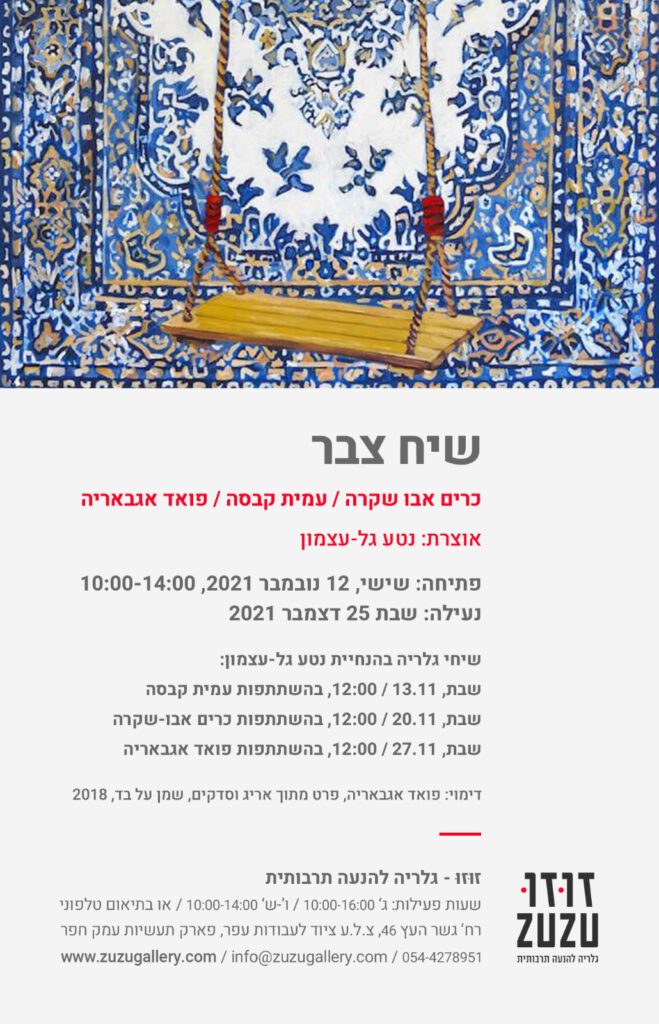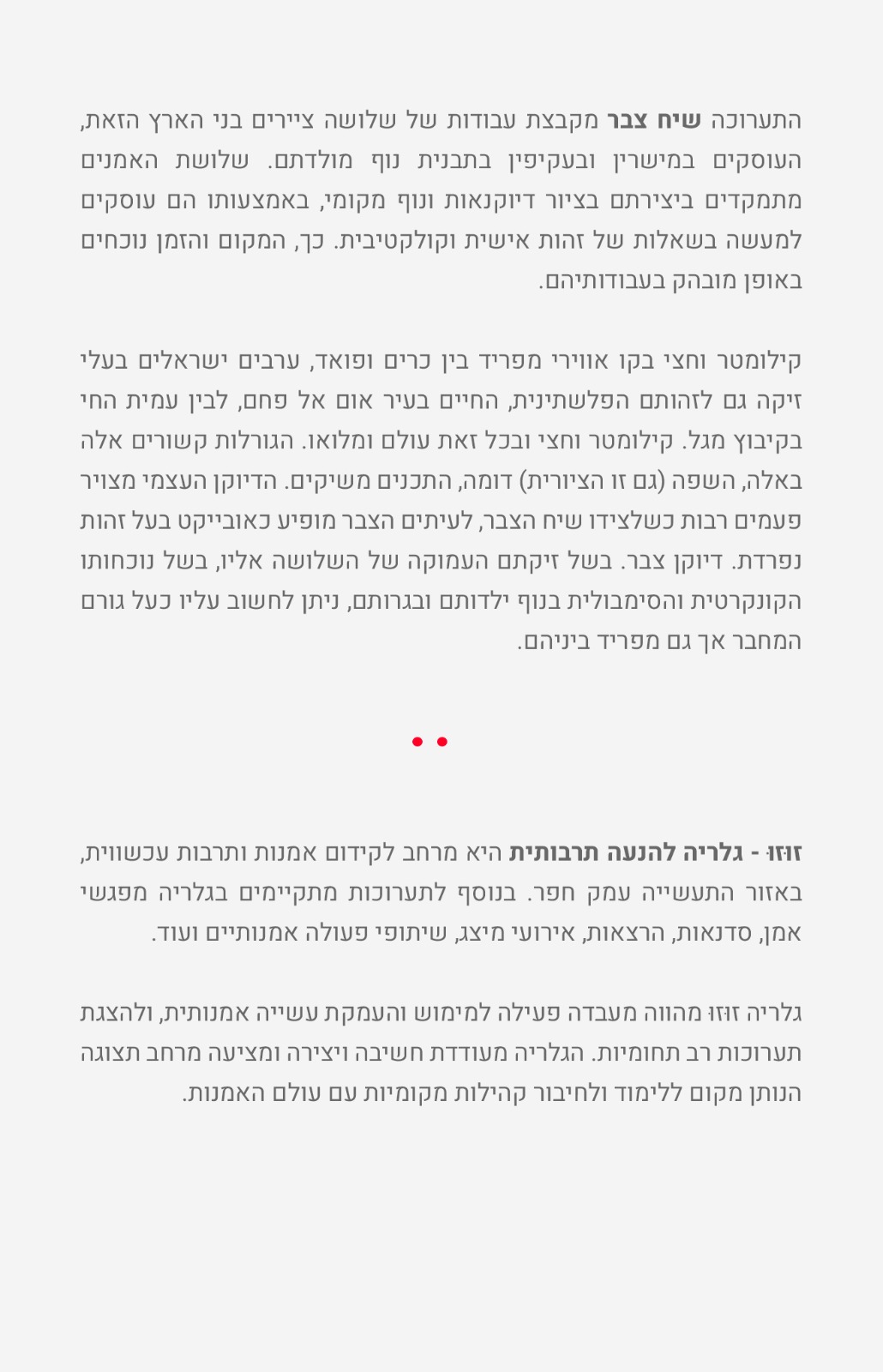Sabra Dialogue
Artists: Karim Abu Shakra, Amit Cabessa, Fouad Agbaria, Sobhyiya Hasan Qais
Featured Project – Artist’s Wall مشروع مميز – جدار فنان: Sobhyiya Hasan Qais
Curator: Neta Gal-Azmon
The exhibition “Sabra Dialogue” brings together the work of three artists born in this country, who deal directly and indirectly with the landscape of their homeland. All three focus on painting local portraits and landscapes, through which they address questions of personal and collective identity. Place and time have a distinct presence in their works. Geographically, just one and a half kilometers separate Umm al-Fahm, the place of residence of Karim Abu Shakra and Fouad Agbaria, Arab Israelis with strong ties to their Palestinian identity, and Kibbutz Magal, where Amit Cabessa resides. A short distance, yet they are worlds apart. The fates of all three are intertwined. Their language (including their painterly language) is similar, and there are parallels in their content. All three often paint their self-portrait beside a sabra plant. Sometimes, the sabra appears as an independent object – a kind of portrait of a sabra. Their deep connection to the sabra plant, which has a concrete presence in the landscape of their childhood and adulthood, transforms it into an element that both connects and divides them.
The sabra plant is closely tied to the ethos of both the Israeli and Palestinian peoples. On one hand, the “new” Jew – the Israeli – the product of the Zionist project, is defined by the harsh, prickly outside of the plant’s fruit, which contrasts with its colorful, sweet inside. The Israeli “sabra” is described as “prickly on the outside/sweet on the inside”. On the other hand, for the Palestinian people, the sabra plant’s strong roots in the local landscape symbolize steadfast perseverance to hold onto the land, the Arabic term “sumud”. The sabra’s continued blossoming on the land’s soil, even in difficult conditions, serves to symbolize and memorialize places once settled by Palestinians which have been erased from the earth. The word that signifies the sabra plant in the Palestinian dialect, “saber”, also means “patience or perseverance”.
In this context, Palestinian poet Mahmoud Darwish wrote of Yehuda Amichai “…we write about the same place. He wants to use the landscape and history for his own benefit, based on my destroyed identity. So we have a competition: Who is the owner of the language of this land? Who loves it more? Who writes it better?”[1]
In this exhibition, I endeavor to propose a possible way of thinking about the complexity of the lives of different peoples in a shared physical space, through three artists who study themselves in connection to a single local plant (which is a strange, curious object in and of itself). They do this through a shared prism – by looking from the inside outwards and from the outside inwards, a two-way movement from the portrait to the landscape and from the landscape to the portrait, turning over and over again within the prickly and sweet, the connected and disconnected. Their inquisitive glance is not conveyed through the intermediary of words or concepts, but rather through the brushstroke, sometimes quiet and precise and at other times stormy and raw. The paintbrush, as an extension of the artist’s hand, moves lightly across the canvas, like thoughts across the earth.
Karim Abu Shakra (b. 1982, lives and works in Umm al-Fahm)
Flora and fauna, which appear quite often in the paintings of Karim Abu Shakra, reveal his sharp eye, which is sensitive to his direct natural environment. In this exhibition, the paintings are exhibited in a busy grouping, in two crowded rows which gather together single images into a kind of “flock”. At the center of the painting’s surface, a single figurative image is usually positioned, “placed” upon an abstract background with a soft, velvety appearance. This background accentuates the image while also charging it with a dimension of poetic presence, which extends beyond the context of any specific landscape or place.
Alongside the spice plants, birds, and cyclamen flowers, one recurring motif dominant in Abu Shakra’s work is the sabra plant – the central image in Palestinian culture from its very beginning. For Abu Shakra, the sabra plant is a starting point for discussing existential, personal, and intimate questions, as well as weighty national issues. There is a particularly active artistic dialogue between Karim and his late uncle, Asim Abu Shakra (1961 – 1990). In many of Asim Abu Shakra’s paintings appears a displaced sabra, planted in a planter. At the beginning of his career, Karim Abu Shakra testifies that he did indeed paint the sabra primarily as a tribute to his uncle Asim, and he still finds a source of inspiration and pride in his uncle’s works.
Over time, he says that he has redirected the charged image to other destinations and has also made it “his own”. By engaging with the sabra plant, he addresses questions of survival, continuity, and self-determination within a difficult and challenging environment. Abu Shakra paints the sabra sometimes as a separate object and sometimes as part of the landscape; sometimes in a realistic style and sometimes abstract. Once it grows in the earth in the courtyard, next it is in a planter inside the house. The sabra is small and modest or large, heroic and wild. It seems that over the years he has transformed the sabra in his work into a kind of platform from which an endless variety of moods, thoughts, and feelings can sprout. For him, this is an image that has formed over the years into a home, through which he connects not only to his familial and national roots but also to his own soul, as an individual and a painter.
Amit Cabessa (b. 1977, lives and works on Kibbutz Magal)
In Amit Cabessa’s series of paintings, painted in 2010, two interlaced elements recur in different variations: the artist’s self-portrait and a tangle of fences and sabra plants. The background remains fixed – Cabessa’s immediate living environment – Kibbutz Magal in the northern Sharon region. From the distance of time, Cabessa defines these paintings as “self-portraits that foretell confusion about identity”.
The four rings of fences that surround Kibbutz Magal (!) often appear in Cabessa’s paintings, and for him, they serve as symbols of defense and suffocation all at the same time. The sabra plants weave into the iron netting in a strange and unusual fabric, which creates a grid composed of synthetic metal and wild, raw and bursting vegetation. The iron and the sabras together symbolize border and territory, containment and control on one hand, while hinting on the other hand at an uncontrollable outburst of the natural and instinctual, which stanchly oppose any sign of imprisonment or culturalization. Alongside the metaphoric limitations it symbolizes, the fence as a recurring painterly element in Cabessa’s paintings unifies the painting’s composition and creates a system of control and order within the painting as well. In many of his paintings, it even constitutes a real barrier to the viewer’s wandering gaze.
Cabessa is aware of the political use of the sabra plant, in both Israeli and Palestinian discourse, but wishes to distance himself from this context. “I was interested in distancing the sabra from its usual national and political meaning and placing it in another, new and apolitical context. For me, this is an interesting object on the level of painting and sculpture. I am interested in the light which falls differently on each of its leaves, as well as its materiality, without engaging in the cultural and political baggage placed upon it. I engage with its topographic composition, its special structure. At the end of the day, an embarrassed person stands before it, who gets pricked by its needles like a nebbish. I paint myself beside it, in front of it and across from it with a big kippa on my head, which could be the kippa of a Muslim, Druze or Jew. It is an anonymous kippa.”[2] In Cabessa’s paintings, there is indeed an attempt to blur the sabra’s historical and political symbolism and transform it into the concrete mold of landscape, but in being molded into the character of the artist, it is charged with weighty meaning – embedded in his flesh, identity and fate.
Fouad Agbaria (b. 1981 in the village Musmus, lives and works in Umm al-Fahm)
Fouad Agbaria’s works are located in the space between the personal and the sociopolitical. This exhibition presents a group of works from three of the artist’s main bodies of work: rugs, portraits and sabra plants. The rugs are a symbol of home, the painter’s private domestic space, and they represent his most intimate and authentic identity as a person. At the same time, the rugs are also an object that symbolizes his spiritual and cultural world by referencing the prayer rugs of faithful Muslims and the tradition of Islamic art which is based on busy decorative ornamentation. On the painting’s surface, which simulates soft yet charged textile, is “stamped” a single, figurative, seemingly banal image taken from the everyday life of an Arab Israeli/Palestinian citizen in this country. The different objects, some of which are very loaded from a political standpoint (tobacco, a warplane, a pile of black tires) stand out as foreign to the repetitive, decorative background of the colorful textile. The unexpected juxtaposition of the two elicits numerous contrasts: inside and outside, meditative and active, tradition and progress, personal and collective.
The artist remembers the sabra well from his childhood in the village Musmus, where he grew up. According to him, the plant’s most dominant trait is that it never becomes extinct – even a dead sabra can generate a live sabra. “For me, the sabra plant is a symbol of survival. Even in places that have been abandoned and villages that have been wiped out, the sabra remains as a symbol on the landscape, testifying to their existence and standing as the village guard. […] it is painted shaped like a wall and prickly, but it is also rich in nutritious fruits, which bear sweet memories […] I take the sabra to a place of decay – a symbol of the decay of Arab society. In later works, deep frustration is expressed about the problem of my status and identity in the State of Israel. […] I express aspects of the suffering I experience, including the collective aspect, but also self-criticism, in order to draw a deep connection between my activity as an artist and the society in which I live, with all of its problems.”[3] Regarding his portraits, Agbaria testifies: “The visual language in which I express myself is actually the language of writing down my memories. Thus, my self-portrait in the present stands as a witness to a time that has passed”.[4]
Neta Gal-Azmon, exhibition curator
[1] Cited in English in Adam Chandler, “The Legacy of Mahmoud Darwish”, Tablet, August 9, 2013, https://www.tabletmag.com/sections/news/articles/the-legacy-of-mahmoud-darwish.
[2] From a discussion with the curator ahead of this exhibition.
[3] From the catalog of the exhibition “Fouad Agbaria, Maps of Memory”, Umm al-Fahm Art Gallery, curator: Varda Steinlauf, 2018, pp. 89-92.
[4] Ibid.


